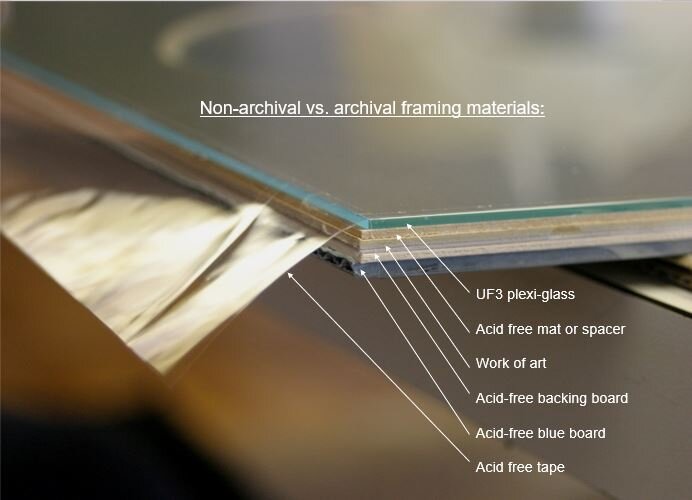Two of the most common issues we see when we examine works on paper at The Conservation Center are mat burn and fading. Mat burn is a line or mark, typically a darkening, caused when an acidic mat has been in contact with a work on paper. Fading occurs when the media or paper used to create a work, such as ink, watercolors or photographic emulsion, lightens due to prolonged exposure to ultraviolet light (UV).
Framing and displaying an artwork properly can help draw attention to a work, enhance its visual appeal, and keep it safe.
We asked one of our paper conservators, Lauren Luciano, to weigh in on just what causes the mat burn and fading we see occurring with many works on paper.
What is mat burn and how can you tell it apart from a print that is fading?
Mat burn is a darkening due to an artwork being in proximity to an acidic mat, so the discoloration will be at the margins (and often in a rectangular shape) on the front and often overall on the back of an artwork. Poor quality mats made from paper with heavy wood pulp content is chemically unstable and acidic. The wood pulp decomposes over time, releasing acid which migrates into the absorbent paper of the artwork.
The effects of acidic matting on a Picasso drawing.
Fading is the diminishing of color or tones often caused by excessive exposure to natural or artificial light such as when an artwork is displayed under a non-UV filtering glazing.
One good way to tell if a work has faded and is not mat burned is that the media underneath the window mat will be more vibrant because it has been shielded from UV light by a mat.
Another example of a piece that has experienced mat burn (before and after treatment).
Is it possible that a work is both faded and mat burned?
Yes, unfortunately this is possible.
Can mat burn be reversed? What about fading?
Mat burn can be reversed if the media and paper are stable enough to undergo water washing. Water washing removes the acidity and degradation products that have been transferred to the paper from the acidic mat.
Fading is, unfortunately, irreversible.
Before treatment of a portrait of Frederick Douglass, which exhibited mat burn reversible with water washing.
After treatment.
A Whistler work after treatment — fading is unfortunately irreversible.
What are the best ways to avoid mat burn and fading or discoloration?
Using acid free materials and UV filtering glazing when framing an artwork can prevent mat burn and lessen the effects of exposure to UV light when a work is being displayed.
A proper framing package includes the following elements to help protect against mat burn.
Every work on paper that is framed at The Conservation Center is enclosed in a conservation grade framing package that is made up of acid free materials and UV filtering glazing. The expert staff in the Custom Framing and Fabrication department use archival materials and museum-standard techniques to ensure the proper protection of your piece.
A Jean Dubuffet in a standard frame.
A Jean Dubuffet in a custom-made, conservation-grade frame.
Interested in learning more about paper conservation? Watch the video below to learn about water washing, a technique used to clean works.










